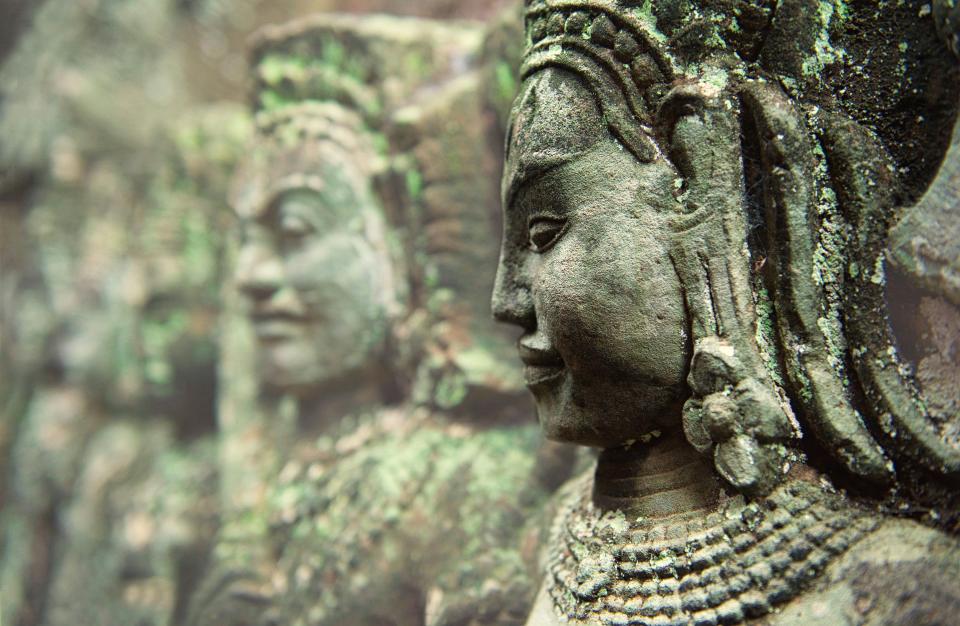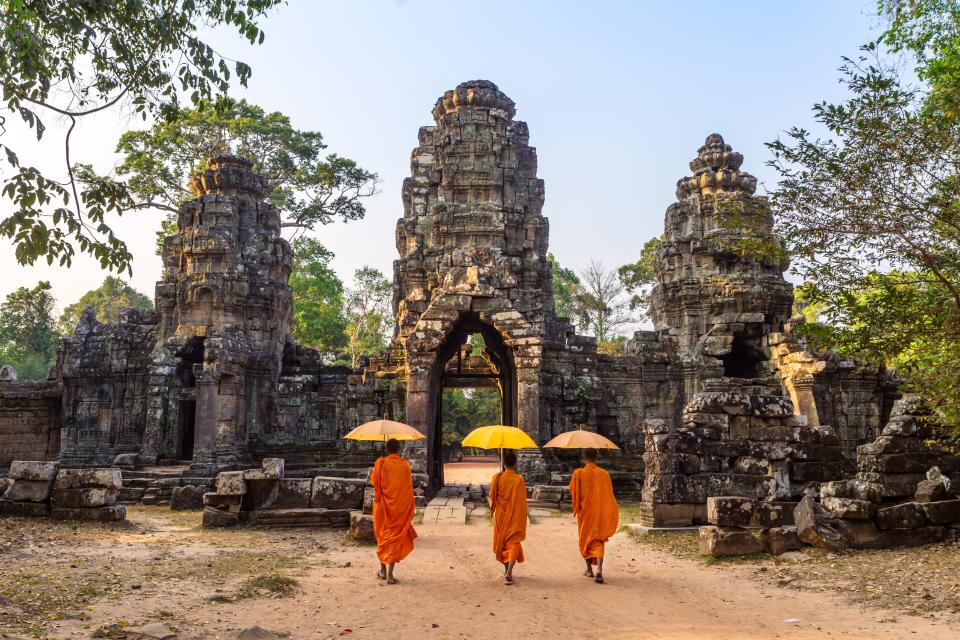3 Days in Siem Reap
Ask any frequent travelers to Southeast Asia, and they'll say Siem Reap in Cambodia is one of the first trips you should take in the region (also: Northern Vietnam, Bali, a food tour of Singapore...). But you may go and never really see the city, opting to pass through it as a gateway to Angkor Archaeological Park—the wonder of the world that draws two and a half million tourists every year (most to see its famed, gotta-get-that-sunrise-photo Wat), dwarfing the 250,000-strong population of the city a few miles to its south.
In a long weekend, you may tire of the temple crowds after a day—but 72 hours is just enough to get a taste of Siem Reap's thriving vegan and vegetarian scene, experience first-hand how a community champions sustainability, and yes, get that photo.
Checking In
Siem Reap is the kind of city where you can book a night at a luxury hotel for budget prices. For US$50 you get a poolside room with balcony and breakfast at the modernist Somadevi Residence. For $300, you can upgrade to a private pool villa surrounded by rice paddies at Phum Baitang. The city’s Park Hyatt hovers at a price between those two, and is reputed as the most affordable hotel in the five-star chain. You can't go wrong at any of those.
Day 1: Finding a Tuk-Tuk and a Temple at Sunset
Drop your bags and flag a tuk-tuk with a destination of Sister Srey. This restaurant is one of Siem Reap’s “social enterprises,” pairing dining with philanthropy. There’s no single-use plastic in sight (even the straws are reusable bamboo), waste is composted or recycled, employees receive advanced language lessons and hospitality training, and 20 percent of the profits go to local charities. The best seats in the open-air restaurant are at the central communal table on the sidewalk; face the street and watch Cambodia fly by, from families squeezed five-together on mopeds to crates full of spiky, stinky durian fruit headed to market. The homemade coconut banana bread drizzled with honey is a must. (Tip: No need to hit an ATM before dining. While having some Cambodian riel is a nice novelty, the de facto currency is the U.S. dollar.)
Set your phone alarm for 5 p.m. and, when that chime goes off, jump in another tuk-tuk to spirit you away to the Angkor ticket center, which is confusingly located outside of town and the archaeological park. It’s here (and only here!) you can buy an “Angkor Pass,” which gets you into the park and will be verified by guards at several checkpoints. Bring cash (or take a chance on the credit card machines) to pay about $37 per person for a single day’s visit, $62 for two days, or $72 for three days; those days don't need to be used consecutively. Now, why the alarm and the rush? If you buy after 5 p.m., you guarantee a ticket for the next full day while still being able to go into the park right away for sunset, without it marking against your day count. If the weather is good, ask your tuk-tuk to speed straight on to Phnom Bakheng, where a 20-minute hike up a wide dirt path puts you atop the small mountain’s temple to Shiva, and in an ideal position to watch the sun sink with Angkor Wat in the distance.
The job of tuk-tuk driver pays pretty well in Siem Reap, so there's no shortage of drivers willing to chauffeur you around all day. This day-long exclusivity is crucial: Angkor is massive, and having the same tuk-tuk waiting for you after each temple visit means you’re able to take it all in on your own time. Agree on a pick-up time and rate for the next day. A full-day tuk-tuk should cost $25, but can reach up to $45 if you want to visit temples farther out, like Ta Som with its restored Apsara carvings. Bargain down any cheaper and you risk having your driver running off on you if he negotiates something better later.
Then, back in central Siem Reap, walk through the Noon Night Market. It's doable in a half-hour and has a greater focus on handmade art versus the city’s main night market, which is next door anyway. Stands serving lok lak (Khmer beef stir-fried with vegetables), spring rolls, and fish amok (fish curry steamed in banana leaf) abound, and if you like what you taste, look for small packets of the amok curry spices for sale. Stroll through “pub street,” its bars spilling over with backpackers swilling 75-cent beers, before calling it a night.

Statues at Angkor Wat complex
Day Two: Tackling the Angkor Temples
Great job: You’ve already got your ticket, so no 5 a.m. queues for you! Sleep in an extra half-hour and order a to-go breakfast box from your hotel, but don’t keep your driver waiting. Sunrise at Angkor Wat is arguably the flagship experience of the park, and although joining thousands may not be your favorite way to spend an early morning, the photos—pond reflections of the temple with the fiery first rays of the day behind—are worth the trouble. Bonus: If you head straight in and line up to explore the upper terraces first, you’ll beat the busloads who either meander around or return to their hotels for the breakfast buffet, showing up later when the sun is highest and hottest (and the line longest). It’s in the upper tiers you’ll find the souvenir of a visit to Angkor Wat: Buddhist monks seated around the complex will say a blessing over you and a tie a thin, red bracelet around your wrist (wear until it naturally falls off) for a small donation.
From Angkor Wat, there are two standard routes to visit: the “Little Circuit” (most common and covering the nearer, most famous sites like Bayon, with its carvings of faces, and the Elephant Terrace) and the “Big Circuit” (more distant sites like the "Tomb Raider temple," but the greatest chance to have a temple to yourself). There’s no rule you need to stick to one circuit, either; so long as your driver’s game, you can mix and match. Head back into town to have a look at the map, recharge batteries, and chug the cool water you’re no doubt fantasizing about; sweating through your clothes is almost a guarantee no matter the season at Angkor Wat.
Before meeting up with your driver for another go at the temples, fill your belly with Khmer pork rice or a vegetarian sweet potato curry at New Leaf, another “social enterprise,” donating 30 percent of profits to local charities that rotate monthly. Organizations like SeeBeyondBorders, a charity that repairs schools and instructs teachers in child-friendly learning methods, receive thousands of dollars thanks to hungry visitors. If you were nervous about trying street food on your first night, this is a second chance to try lok lak and amok curry.
Hopefully New Leaf’s housemade limeade slush has prepared you for a return to the heat, since the second half of today’s temple marathon takes you through the Little Circuit, to Angkor Thom and its structures both hulking and intricate. Buddhist Bayon temple is the second-most-selfied site after Angkor Wat, for its 54 giant towers each carved on four sides with the face of Avalokiteshvara. But save some camera battery for the Elephant Terrace, too, as its hundreds of stone pachyderms once welcomed the Khmer imperial army back from battle.
Finally, your tuk-tuk driver will make sure you don’t miss a visit to Ta Prohm, just outside the Little Circuit but well worth the extra 10-minute drive. It's also known as the “Tomb Raider temple” for its appearance in the movie starring Angelina Jolie. Time has seen tree roots overtake the stonework, and the resulting sylvan maze is equal parts post-apocalyptic fantasy and a sobering reminder of our humanity.
Back in town, reward yourself for a long day well touristed by stretching out on the raised dining platforms covered with Thai-style triangular pillows in the gardens at Peace Cafe. Sip from a fresh, whole coconut between bites of Tuk Kroeung Khmer, a traditional dish of garlic, chili, and peanut enjoyed with bread or brown rice. Strong stomachs should instead continue the day’s adventure with dinner at Bugs Cafe, which is exactly what you’re thinking. It’s no gross-out gourmet; the restaurant presents tempura tarantulas, scorpion papaya salad, and cricket cupcakes as fine dining, plated so well you’ll hardly tell that the main ingredient in your spring roll is ants.
Day Three: An Espresso, a Massage, and a Swim in the Pool
Swing back into the Angkor Archaeological Park for any temples you didn’t get around to yesterday (if you have a multi-day ticket), but as tempting as it is to spend your entire visit to Siem Reap Indiana Jones-ing around, don’t come all this way and miss Siem Reap proper. Day three is the fun, relaxing day! Finally have that refreshing dip in the hotel pool, schedule an hour-long Khmer massage at the lilypad-lined Bodia Spa—Khmer-style means more stretching and body alignment than Swedish deep-tissue—and keep the good vibes flowing with a snack of homemade chili chia jam and cashew cheese on wholemeal bread at Cambodia’s first completely vegan cafe, Vibe, whose foundation feeds 10,000 Cambodian school children each year. A few doors down is The Little Red Fox, serving up the best espresso in Siem Reap to the tune of Cambodian rock and roll. Take your coffee upstairs to the small balcony overlooking the street and send off some envy-inducing, cute-coffee-between-massages-and-temples photos to friends stuck in their daily grinds back home.
Sweating in the sun while trekking through temples, swimming laps in a cool hotel pool, eating clean and fresh at sustainable restaurants—who knew Siem Reap had such potential as a detox destination? Not so fast. Atmospheric bars like Miss Wong and Asana Old Wooden House will quickly replenish all those calories you hiked off earlier. The latter, the only traditional timber house still standing in the market district, offers a class in Khmer cocktails from 6 to 8 p.m. daily and hosts a farmers' market on Sunday morning.


